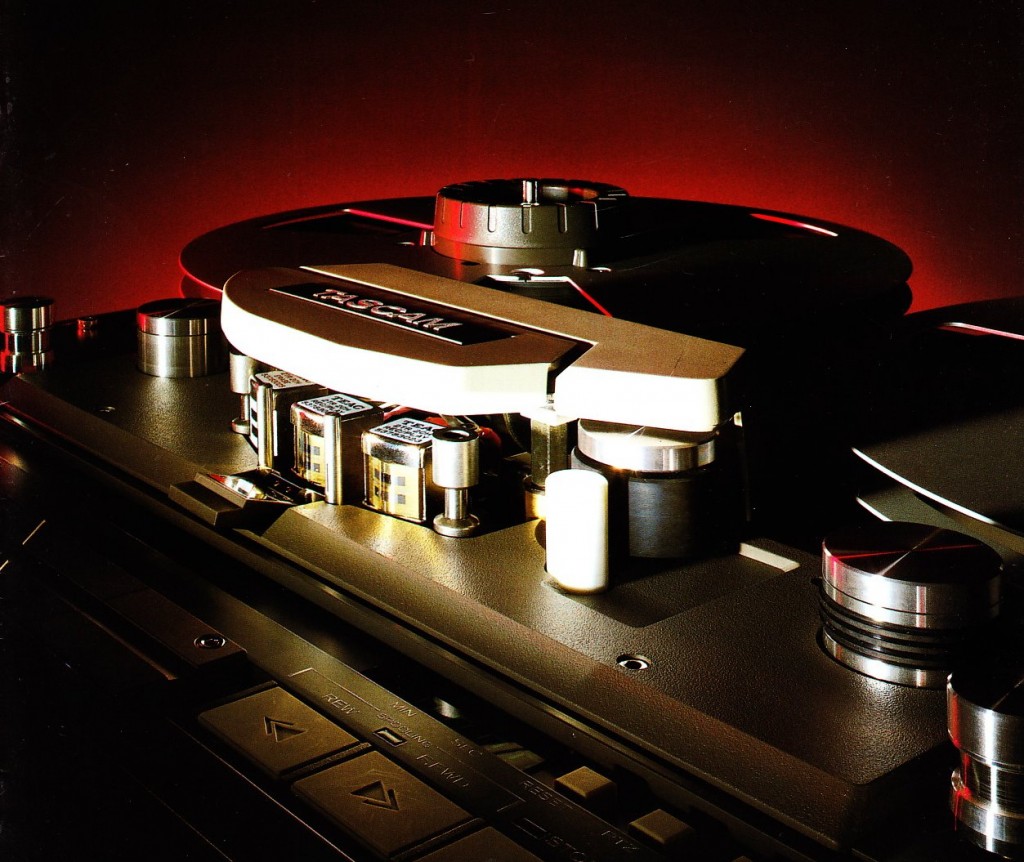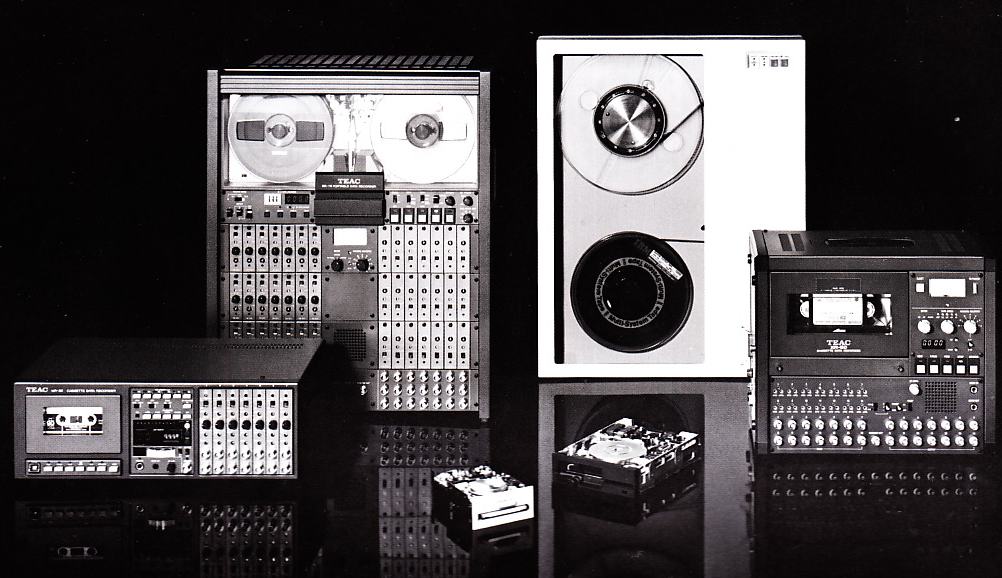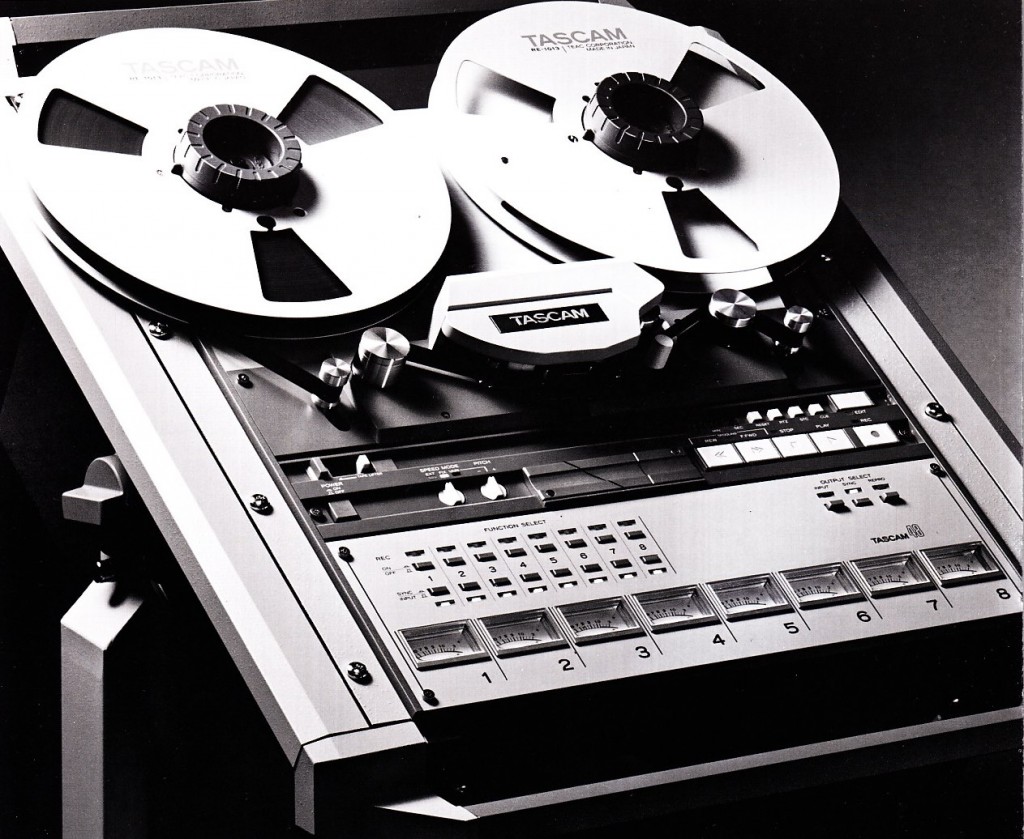 Download the complete twelve-page Tascam Series 40 catalog, c. 1984:
Download the complete twelve-page Tascam Series 40 catalog, c. 1984:
DOWNLOAD: Tascam40series1984
Products covered, with extensive text, specs, and photos, include: Tascam 42 1/4″ stereo tape machine, Tascam 44 four-track 1/4″ tape machine, and Tascam 48 1/2″ eight-track tape machine.
 above: Tascam’s various data recorders of the early eighties. 21-track 1/2″ anyone?
above: Tascam’s various data recorders of the early eighties. 21-track 1/2″ anyone?
Tascam helped create the category of ‘home-recording-studio’ in the 1970s with their 4-track reel to reel machines. The 3440, Teac 3340, and Tascam 40-4 and 80-8 tape machines were the backbone of thousands of home studios and project studios. This line-up was improved in the 1980s with the introduction of the Series 40. The Tascam 42, 44, and 48 tape machines offered better performance than the older models, plus standard features such as balanced i/o, varispeed, and confidence monitoring (IE, they are all three-head decks). The battleship-grey finish of the series 40 lets you know that these are commercial/industrial machines, and the 70/80 lb weight reinforces that idea. (N.B. – Tascam also offered a series 50 with even better specs; i have no direct experience with these machines tho…)
The Tascam 48
Many years ago I inherited a couple dozen pro reel-to-reel machines from a media company that had updated to DAT. Otari 50/50s, Tascam 22s and 32s, Technics 1500s, etc… The best unit of the bunch was a Tascam 44. The operational characteristics and sonics of that machine were incredible. It is long gone now, like all the others, sacrificed to pay-the-rent in late 90’s Williamsburg. It’s one of the few studio pieces that I really regret selling. I don’t think I would ever go back to analog tape as a working production format, but as an effect of sorts analog tape has a quality that nothing else can deliver. Just yesterday I was in the studio with E’s Marantz dual-cassette deck, bouncing some submixes onto a Type 1 Sony cassette and then back into Pro Tools, trying to get just the right amount of high and low end breakup. I got it right after about ten attempts with different level settings. A three-head machine would have been very useful in that situation… especially one with varispeed.
Anyone still using a Tascam 44 or 48 for music production? Drop a line and let us know…

19 replies on “The Tascam Series 40 tape machines of the 1980s”
TEAC/Tascam/Tampex (TEAC built machines marketed via Ampex) machines were in heavy use in radio production environments when I was an assistant engineer, but they were considered a step down from real Ampexes. The Ampexes just worked better, especially (I hate to say it) after you replaced their electronics with Inovonics solid state ones.
Those machines have survived better than the stock ones, which often had their transports dumpstered by some idiot who wanted to make a phat toob mic pre. The Ampex tube electronics weren’t that great anyway, but the transports are irreplaceable. The Inovonics electronics can be made to sound great, or you can build your own (solid state or tube) repro electronics. You’d need the right coils to make bias oscillators but they could be wound.
The real Ampexes were insanely priced though-Lang and others made clones, but it did little to force Ampex pricing in line with reality, because the guys that wanted a 300, 350, AG351 or AG440 were not price sensitive. In the pre-Reagan days, successful businesses needed to put the cash in equipment or pay it in taxes. (Now, for better or worse, it just goes into the capo’s (CEOs) pocket.) The TEAC/Tascam and other imported con/prosumer machines were good enough to produce good work if you were patient and careful, and they would last long enough to learn the art of home studio recording and maybe do your first album.
Recorded our entire first record on the 48! Chris, I know this does not count as my blog entry.
HaHa right. We’re gonna get a subbass expose, yea?
LOL. i can;t believe i forgot y’all use that machine… proves my point! they are fantastic! The rest of y’all…… pick up The Stepkids debut LP on Stones Throw records… some fantastic, soulful, and truly imaginative music+sounds. c.
I am presently looking for a (table model) Tascam 42 or 52 or the Otari MX 50 or 55. Please reply to> rbw@power800voicemail.com
Thanks much.
I just got a Tascam 48, a great machine! I already have a Studer A80 and an Otari MX5050B2 so couple of different flavours there…
You wouldn’t happen to have a manual for the 48? I’ve searched high and low but nobody seems to have it. A lot of deks still around but no manuals. Stange.
I’m looking at picking up a 44-OB from a very generous retired audio engineer in a couple of weeks time. He said it needs a new pinch roller as the old rubber surface is coming apart. There’s a sticker on the back saying it was serviced in 1994. Funny to think that’s almost twenty years ago now. Seems like it should be a good unit if I can get it up to spec!
Nice one evan!!!! I really, really regret having sold mine. Good luck with it – c.
Thanks, Chris!
I had the 44-OB serviced by the local (North Melbourne) reel to reel service guy, but I tried the machine out today and as far as I can tell the performance is a bit weird / off spec.
I don’t know, maybe I’m not using it right?
If anyone has the user manual, please shoot me a line (or a .pdf copy?) to evanlorden@gmail.com
THANKS
(:
To be more specific on my “tests”, here’s what I did:
I just had one mic plugged in (via mic preamp) to each of the Tascam’s XLR balanced inputs and recorded onto a tape which already had some old material on it. The pre-existing material on the tape sounds fine and clear on playback.
Monitoring the input to the Tascam I get a good clear signal and the VU’s show healthy signal level.
But when recording and then listening back to the test signal (drums) what I hear is the original pre-recorded material that doesn’t seem to get erased properly from the tape, and the new signal is both crusty and unclear / distorted.
Maybe I should try it with another tape?
Maybe the erase or record heads are dirty?
I did notice that the recorded signal on track two what a lot clearer than that on track one.
Not sure what’s going on there..
I’m also not sure what the EDIT button is for?
Any tips or suggestions invited!
CHEERS again,
Evan.
Yeah I’ve got one of these – the #48. The sound is excellent. I cannot imagine going to the flat generic sound of digital when you can listen to the FAR SUPERIOR sound of analog tape. Nothing beats it.
I have a tascam 48 reel to reel i purchased from a friend in the 80’s . im looking to get a couple of the rec play boards repaired or buy . I also have a tascam 22-4 to possibly sell
I have a tascam 42-b-nb that im looking to sell ..please call 6264048202
I have a Tascam 40-4 that came from the Experimental Music Dept. at USC. Still works. I bought it chiefly to use to play pre-recorded quad tapes, which it does well. It is the heaviest piece of audio gear I have ever moved — be warned. I also have the similar but smaller 3440S, which sounds just as good to me.
Two Tascam 44’s for sale in Jacksonville, Florida. Working and in fair condition.
Peter, do you happen to have a user manual for a Tascam/Teac 44-OB? I bought one for my Peruvian brother-in-law who loves it but needs the user manual, brought it over there on a plane! thanks.
I purchased a hard copy complete set of Tascam 44OB manuals from rolf@consolidated.net for $56 including shipping within the US. 164 pages + schematics.
Thank you Robert, I just found your reply and luckily I have ended up with the 44OB, he just wanted a two track to play pre-recorded tapes. I’ll check out that email address you gave me. This machine was restored in 20216 and has had very little use since then.
i am looking for a hub that the tape goes oh to 40-4 reel to reel tascam
Hi,
I came into a Teac Tascam 40-4 with the dbx unit (DX-4) and The Teac Tascam Series 3 Mixer but for the life of me cannot figure how to connect them together. I have all the patch cables but don’t know how the 40-4 connects to te DX-4 (bottom bay) and how the M3 mixer interfaces. Unfortunately, I don’t have a manual (if someone could email me a link or the pdf, I would be grateful (murugan19@hotmail.com). HFE has a manual but it is for the 40-4 without the DX-4. The link above (rolf@consolidated.net) may not be working as my email bounced. Thank you in advance, MR